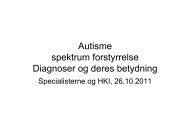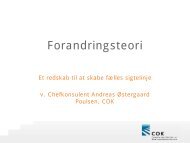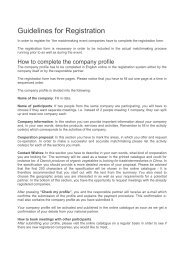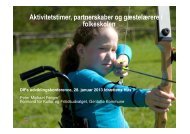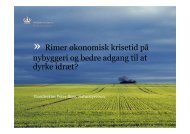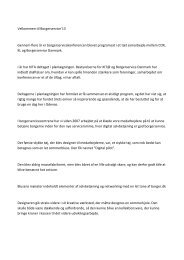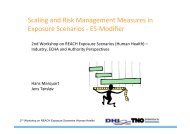11-13 May 2012 Helsingør - Denmark www.networkbio.org
11-13 May 2012 Helsingør - Denmark www.networkbio.org
11-13 May 2012 Helsingør - Denmark www.networkbio.org
You also want an ePaper? Increase the reach of your titles
YUMPU automatically turns print PDFs into web optimized ePapers that Google loves.
ROBERT J WEAThERITT1, NORMAN E DAVEY1, TOBY J GIBSON1<br />
1 STRUCTURAL AND COMPUTATIONAL BIOLOGY UNIT, EUROPEAN MOLECULAR BIOLOGY LABORATORY,<br />
MEYERhOfSTRASSE 1, 69<strong>11</strong>7 hEIDELBERG, GERMANY<br />
Linear Motifs confer functional diversity onto splice variants<br />
The pre-translational modification of mRNAs by alternative promoter usage and alternative splicing is an<br />
important source of pleiotropy. Despite intensive efforts, our understanding of the functional implications<br />
of this dynamically created diversity is still incomplete. Using the recent expansion in our knowledge of the<br />
interaction modules within intrinsically disordered regions, we analysed the occurrences of protein modular<br />
architecture within alternative exons. We find that regions affected by pre-translational variation are enriched<br />
in linear motifs and phosphorylation sites suggesting that the modulating of exons containing these interaction<br />
modules is an important regulatory mechanism. In particular, we observe PDZ, PTB and SH2 binding<br />
motifs are particularly prone to be altered between splice variants. We also determine that regions affected<br />
by alternative promoter usage are enriched in IDRs suggesting that protein isoform diversity is tightly coupled<br />
to the modulation of IDRs. This study therefore demonstrates that short linear motifs, and to a lesser<br />
extent phosphorylation sites, are key components for establishing protein diversity between splice variants.<br />
abStractS For PoSterS abStractS For PoSterS<br />
MISS SOPhIE KERShAW, DR. JAMES OSBORNE, PROf. hELEN BYRNE, PROf. DAVID GAVAGhAN.<br />
DEPARTMENT Of COMPUTER SCIENCE, UNIVERSITY Of OxfORD; COLLABORATION WITh ThE WEAThER-<br />
ALL INSTITUTE fOR MOLECULAR MEDICINE, UNIVERSITY Of OxfORD.<br />
Proliferation and Cell Fate in the Colorectal Epithelium<br />
Endemic across the developed world, the prevalence of colorectal cancer (CRC) has not been matched by<br />
equivalent success in pharmaceutical development. Drug failure in clinical trial patients after early-stage<br />
success in laboratory tests motivates a more detailed consideration of the<br />
fundamental differences between in vitro and in vivo cell behaviour. To what extent does tissue geometry<br />
influence expression of the subcellular biochemistry in CRC?<br />
We therefore present a novel framework for in silico translation experiments, enabling experimental hypotheses<br />
to be explored through simulations of colorectal tissue. Developed in collaboration with biochemists<br />
at the Weatherall Institute of Molecular Medicine, we provide a representation of colorectal tissue that incorporates<br />
mathematical equations to govern the biochemical behavior of its constituent cells. Our focus rests<br />
on models for two key pathways implicated in early-stage CRC, namely Notch (involved in cell fate specification)<br />
and Wnt (a governor of proliferation).<br />
We present our model for Notch and Wnt signalling, based upon existing models in the literature, and incorporate<br />
crosstalk between the two pathways. We will discuss an embedding of our model within cells of both<br />
monolayer and colorectal geometries, discussing the spatial constraints imposed in these two scenarios and<br />
demonstrating the resultant cell patterning and proliferative behaviour.<br />
This work presents a new approach to CRC modelling on several counts. Firstly, via the inclusion of crosstalk<br />
between Notch and Wnt pathways to demonstrate coupled control over proliferation and lineage decisions.<br />
This research also represents a novel development in modelling the<br />
Notch-Wnt interaction in situ, in its application of multiscale frameworks to examine the impact of tissue<br />
configuration.<br />
46 / INB <strong>2012</strong> • <strong>11</strong>-<strong>13</strong> <strong>May</strong> <strong>2012</strong> <strong>www</strong>.<strong>networkbio</strong>.<strong>org</strong> / 47




